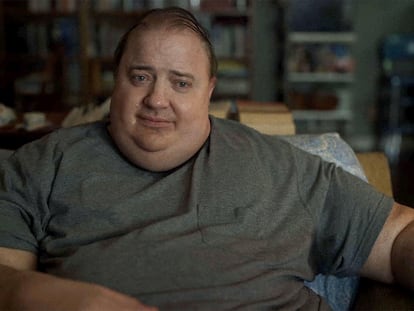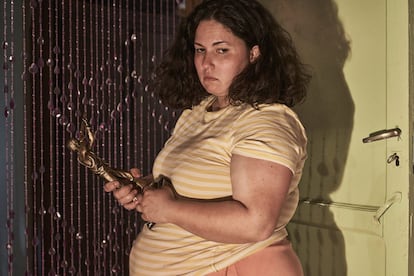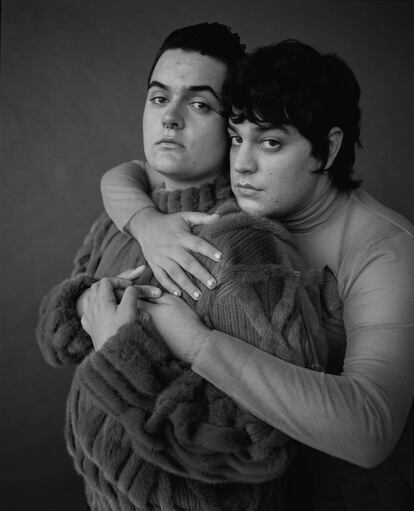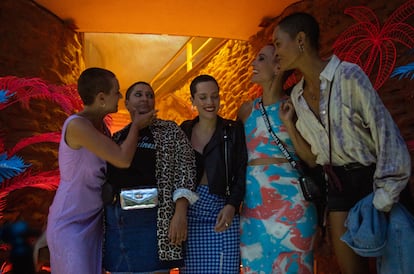Fatphobia on the screen: Society ‘would really prefer for fat people not to exist in public’
The lack of body diversity and representation of fat characters is one of the biggest taboos in the entertainment industry

Contemporary TV fiction does not shy away from polarizing topics. From the capitalist nightmare of Severance (2022) to the mental health issues of Euphoria (2019,) shows increasingly incorporate social debates into their plot lines in response to a growing interest. Gone are the years of the 1990s escapism of Friends and The Office’s controversial canned laughter. Now, for a show to succeed, it must actively participate in the cultural conversation.
This trend is particularly reflected in awards like the Golden Globes, which recently recognized socially engaged productions such as Abbott Elementary or The Bear. Despite this progress, most of these shows haven’t yet broken one of the last taboos in fiction: the lack of body diversity and representation of fat characters.
Anti-fatness is an accepted, widespread discrimination – tiny airplane seats, body-related comments – and fat people remain culturally marginalized. Society “doesn’t like talking to fat people, looking at fat people, believing fat people [and] listening to fat people,” says Lyla Byers, a researcher at Virginia Tech. “We would really prefer for fat people not to exist in public.”
As a result, obese people can suffer serious health consequences. “When I was a child, I suffered medical violence; I was very thin but a pediatrician put me on 18,000 diets,” says Spanish actress Laura Galán Montijano, who starred in the award-winning Piggy (2022). “She was obsessed with my weight, she used to weigh me every week.”
Even some medical terms like “obesity” or “overweight” are problematic, based on a non-inclusive metric: the body mass index (BMI). “BMI was never meant to be used to measure individual health,“ says Byers. “It’s way too simple a measurement for way too complex an issue,” adds Jennifer Graves, author of Framing Fat, a book that challenges the dominant weight discourses. “There are still significant civil rights issues that fat people face in terms of lack of protection against discrimination in the medical system.”
Laziness, stupidity, gluttony or having low sexual capital are some of the concepts associated with fat people, according to Jeanine Gailey, a sociology professor at Texas Christian University. “The cultural messaging is that fat is the worst thing one can be,” Gailey says. These stigmas are internalized by producers, who fail to include diverse perspectives. “When [women] are not desirable according to beauty standards, we’re not featured on screen,” says Montijano.

And, when fiction does introduce fat characters, they are often reduced to old-school stereotypes, from the bullied girl of Debby Ryan’s Insatiable (2018) to the idiotic, slothful Homer Simpson. “Many people in society watch these shows or these movies, internalize these portrayals and believe these things about fat people,” says Ariane Prohaska, a researcher at the University of Alabama. “It leads us to treat fat people differently and to treat ourselves differently, in a way that makes us believe that we have to constantly be improving our bodies.”
Reducing obese people to caricatures especially affects traditionally marginalized minority groups, such as women, people of color and the LGBTQI+ community. “Body size intersects with other dimensions of oppression,” says Prohaska. “So, women of color, particularly Black women, face a lot of stigma.” Big Shirley, a recurring character on the television show Martin, is a classic example of a problematic portrayal of fat Black women on TV, as is America Ferrera’s character on Ugly Betty.
Fat white women have managed to diversify their roles in American fiction thanks to the work of actresses like Melissa McCarthy or Lena Dunham. But “Hollywood Fatness” is not representative of the US a whole. Chrissy Metz, for example, said in 2016 that as part of her This is Us contract, where she played a woman struggling with eating habits, she had to lose weight. Later, however, she retracted her comments. “Gatekeepers, the people who are behind the scenes deciding what stories Americans are going to buy, tend to be white, wealthy and male,” says Virgie Tovar, a writer and expert on body discrimination. “This creates a cycle of the same kinds of stories being told over and over again.”
When it comes to queer men, fiction narrowly focuses on the body cult that characterizes part of the community through masculine, beefy characters such as those in Élite (2018,) Smiley (2022) or in the last season of American Horror Story. “It really is paradoxical that the diversity the LGBTQI+ community demands is not practiced within it,” says Roberto Enríquez, critic and creator of Queer You Are (2021.)
In the show, Enríquez self-fictionalizes his own youth through Gabriel Sánchez and Carlos González, who embody the double discrimination the director has suffered because of his sexual orientation and his body. “I was clear that, if I was going to do the show, I was going to do it my own way,” says Enríquez. “They had to be fat characters because that was the story I was telling, how they face life with those bodies, how they face rejection and desire.” In an interview for ICON, Sánchez spoke of the danger of stereotyping fat people. “If you’re fat, they make you do fat things. ‘I fall down and break the chair because I’m fat; I’m fat and I eat four pastries in 10 minutes.’ The fat guy always has scenes where he is binge-eating.”

If LGBTQI+ stories are still disruptive, triggering far-right censure, those that incorporate artists with non-normative bodies, away from the imposed canon and with plots beyond those of physical obsession, have an even greater subversive impact. “Queer bodies and fat bodies are seen as excessive, so when you have queer fat bodies, they are doubly destabilizing,” says Jason Whitesel, a sociologist at Illinois State University and author of Fat Gay Men, which examines fat stigma within gay male communities. “Most of our shows are put together by people who think the queer community is best represented by thin or muscular people.”
Even though fat suits are still employed by the entertainment industry, fiction has progressed from the rather cringeworthy “Fat Monica” episode of Friends. In The Girls at the Back (2022,) Mariona Terés plays Leo, a millennial woman who plans a trip with her friends after one is diagnosed with cancer. Terés, with a leading, cliché-free role, believes that many things have changed in recent years, albeit slowly. “We are seeing different bodies on screen, but we have to keep changing the clichés,” she says. “The next step is a fat woman playing a sexy character, in a romantic relationship with someone, and normalizing that her body is beautiful, that she can eat whatever she wants and fuck whoever she wants.”

Besides expanding the narrative complexity of fat characters, fiction must increase their range of roles away from one-dimensional supporting characters haunted by their physical appearance.
“What I hope is that diversity is broadened in all senses,” says Carlota Pereda, director of Piggy. Without financial support from production companies, projects with leading fat characters will struggle to be developed. “When you’re looking for funding, some people won’t support you because they consider it a personal project just because you’ve put a non-normative character in the leading role.”
Although fiction lags behind a society that is largely critical of negative representations of fat characters in productions like The Whale, the industry will eventually accept that non-Hollywood bodies exist and deserve to be represented, with complex storylines and free from humiliating fat suits. “I do think we’re going to see more and more diverse people on screen,” says Terés. “It’s a slow road, but we’ll get to the other side.”
Sign up for our weekly newsletter to get more English-language news coverage from EL PAÍS USA Edition
Tu suscripción se está usando en otro dispositivo
¿Quieres añadir otro usuario a tu suscripción?
Si continúas leyendo en este dispositivo, no se podrá leer en el otro.
FlechaTu suscripción se está usando en otro dispositivo y solo puedes acceder a EL PAÍS desde un dispositivo a la vez.
Si quieres compartir tu cuenta, cambia tu suscripción a la modalidad Premium, así podrás añadir otro usuario. Cada uno accederá con su propia cuenta de email, lo que os permitirá personalizar vuestra experiencia en EL PAÍS.
¿Tienes una suscripción de empresa? Accede aquí para contratar más cuentas.
En el caso de no saber quién está usando tu cuenta, te recomendamos cambiar tu contraseña aquí.
Si decides continuar compartiendo tu cuenta, este mensaje se mostrará en tu dispositivo y en el de la otra persona que está usando tu cuenta de forma indefinida, afectando a tu experiencia de lectura. Puedes consultar aquí los términos y condiciones de la suscripción digital.
More information
Archived In
Últimas noticias
The metaverse, four years later: Is it finished or just at a standstill?
$3,000 and a plane ticket: The United States increases incentives for migrants to self-deport before the end of the year
Charles Dubouloz, mountaineering star, retires at 36 with a farewell tour inspired by Walter Bonatti
From the White House to diplomatic gifts: Lego wins over adult fans, brick by brick
Most viewed
- The low-cost creative revolution: How technology is making art accessible to everyone
- Christian Louboutin: ‘Young people don’t want to be like their parents. And if their parents wear sneakers, they’re going to look for something else’
- All the effects of gentrification in one corner of Mexico’s Colonia Roma
- Christmas loses its festive spirit: ICE fears cast shadow over religious celebrations
- Liset Menéndez de la Prida, neuroscientist: ‘It’s not normal to constantly seek pleasure; it’s important to be bored, to be calm’










































